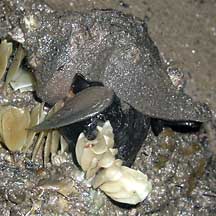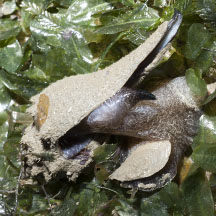Melongena
snails
Family Melongenidae
updated
Aug 2020
Where seen? Some large melongena snails are commonly seen
on many of our shores, usually in estuaries or near mangroves.
Features: Shell large and thick.
They have a tough operculum made of a horn-like material. They lay
egg capsules in orderly rows on rocks and other hard surfaces.
What
do they eat? Many species of melongena snails eat bivalves,
especially oysters.
Human uses: They are collected
for food by coastal dwellers and the shell used to make lime. |
| Some Melongena snails
on Singapore shores |
Family
Melongenidae recorded for Singapore
from
Tan Siong Kiat and Henrietta P. M. Woo, 2010 Preliminary Checklist
of The Molluscs of Singapore.
|
| Links
References
- Tan Siong
Kiat and Henrietta P. M. Woo, 2010 Preliminary
Checklist of The Molluscs of Singapore (pdf), Raffles
Museum of Biodiversity Research, National University of Singapore.
- Chan S-Y (2009) The Melongenidae (Mollusca: Gastropoda) of Singapore. Nature in Singapore, 2: 63–67.
- Tan, K. S.
& L. M. Chou, 2000. A
Guide to the Common Seashells of Singapore. Singapore
Science Centre. 160 pp.
- Wee Y.C.
and Peter K. L. Ng. 1994. A First Look at Biodiversity in Singapore.
National Council on the Environment. 163pp.
- Ng, P. K.
L. & Y. C. Wee, 1994. The
Singapore Red Data Book: Threatened Plants and Animals of Singapore.
The Nature Society (Singapore), Singapore. 343 pp.
- Abbott, R.
Tucker, 1991. Seashells
of South East Asia.
Graham Brash, Singapore. 145 pp.
|
|
|


